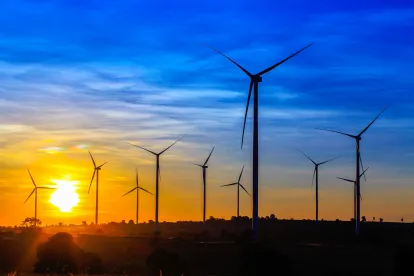From June 21 to June 25, the Louisiana Governor’s Office in coordination with the Coastal Protection and Restoration Authority, Louisiana Economic Development (LDED), and the Louisiana Department of Natural Resources (LDNR) hosted Louisiana Wind Week, a series of online sessions that discussed how offshore wind energy could become part of the state’s energy future.
Jones Walker’s offshore wind team attended sessions, and what follows is a summary of each day’s proceedings. For further information, recorded sessions can be found online.
Monday, June 21: Offshore Wind Leasing and Administration Priorities
-
Gov. John Bel Edwards — Welcome
-
Harry Vorhoff, Deputy Director, Governor’s Office of Coastal Activities
-
Amanda Lefton, Director, Bureau of Ocean Energy Management (BOEM)
-
Michael Celata, Regional Director, BOEM, Gulf of Mexico Region
-
Thomas Harris, Secretary, LDNR
-
James Devitt, Deputy General Counsel, LDNR
-
Greg Roberts, Petroleum Lands Director, LDNR
-
Don Pierson, Secretary, LDED
Day One of Louisiana Wind Week focused on the overall regulatory framework applicable to offshore wind leasing and both the federal and state initiatives to pursue offshore wind energy in the Gulf of Mexico.
BOEM’s representatives explained that BOEM is committed to combating climate change and that BOEM is looking to responsible offshore wind development as an opportunity to create good-paying jobs. They also emphasized that, given the existing robust oil and gas industry in the Gulf South, the Gulf of Mexico is “well positioned” to transition into offshore wind energy development. Regional Director Mike Celata outlined the federal leasing process for offshore wind energy development (Planning & Analysis, Leasing, Site Assessment, and Construction & Operations) and explained that BOEM is currently engaged in the Planning & Analysis stage in the Gulf of Mexico. He also repeatedly emphasized the importance of the public’s participation through response to the recent Request for Information (RFI) published by BOEM.
The State of Louisiana’s representatives also emphasized their hope to see the offshore wind industry take off in the Gulf of Mexico. They described the leasing framework that applies under Louisiana law to offshore wind leases, which framework has been in place since 2005.
Overall, the message conveyed in Day One of Louisiana Wind Week was that both the Department of the Interior, within which BOEM sits, and the State are eager to see the offshore wind industry take off in the Gulf of Mexico and that the Gulf of Mexico offers a unique advantage over other US offshore locations for wind energy development, as there is already extensive expertise in offshore energy development in the Gulf South.
Tuesday, June 22: Minimizing Potential Environmental Impacts
-
Erica Rule, Chief of Staff for Science Planning and Operations, National Oceanic and Atmospheric Administration (NOAA)
-
Randy Wilson, Supervisory Wildlife Biologist, US Fish and Wildlife Service
-
Rebecca Green, Senior Scientist, National Renewable Energy Laboratory
-
Patrick Banks, Assistant Secretary for Fisheries, Louisiana Department of Wildlife and Fisheries
-
Randy Myers, Assistant Secretary for Wildlife, Louisiana Department of Wildlife and Fisheries
-
Catherine Bowes, Program Director, National Wildlife Federation
-
Brent Newman, Deputy Director, Audubon Louisiana
Day Two of Louisiana Wind Week, Erica Rule, Chief of Staff for Science Planning and Operations, NOAA, focused her remarks on the need to understand the impacts of offshore wind farming on trust resources and fisheries. She stated that NOAA collects data on fisheries and that in the Gulf the agency is particularly concerned with fishing and shrimping. Ms. Rule listed the following trust resources:
-
Fisheries
-
Marine mammals and sea turtles
-
Fish and invertebrates
-
Ecosystem (how the systems work together, including human activities)
Ms. Rule explained that it is important to understand cumulative impacts of offshore projects. NOAA collects data to help inform decisions on wind farming, including data on species distribution and status. With respect to offshore wind development, Ms. Rule listed the following as concerns:
-
Hydrodynamics
-
Sound during life cycle
-
Increased vessel activity
-
Electromagnetic fields
-
Artificial reefs
Randy Wilson, Supervisory Wildlife Biologist, US Fish and Wildlife Service, addressed birds and migratory pathways. Mr. Wilson explained that with respect to migrating birds, most roads lead to the Gulf of Mexico. His focus was on factors that impact birds. He said that there are around 400 species of birds that use the Gulf of Mexico during migration and that the total number of birds using the Gulf during spring is likely over 3 billion. With respect to offshore wind development in the Gulf of Mexico, Mr. Wilson stated that the things to consider are migratory patterns, pathways, and habitat of residents.
Rebecca Green, Senior Scientist with National Renewable Energy Laboratory (NREL), spoke on minimizing environmental effects from offshore wind energy development. Ms. Green discussed ways to learn from other locations of offshore wind development. She listed several types of mitigation and monitoring efforts that have been required in the Atlantic region of the United States and that could be applied in the Gulf of Mexico.
NREL is conducting research to synthesize existing knowledge about impacts of offshore wind development, including noise, collision risks, impacts of cables on marine life, electromagnetic field effects, and technology. As an example, NREL is testing strike detection sensors to assess mortality risk to birds. NREL is also establishing a database for technologies to monitor and mitigate environmental effects of wind energy and will be making that information available online.
Day Two of Louisiana Wind Week concluded with a roundtable discussion. Generally, the consensus of the roundtable was that regulators and nongovernmental organizations are excited to get this discussion on environmental impacts started early in the development of offshore wind farming in the Gulf of Mexico. There was an overall emphasis from the roundtable speakers on cumulative impacts and taking a holistic approach, considering how all proposed and future projects as a whole based on expected development would impact the Gulf of Mexico.
Wednesday, June 23: Engaging Existing Users and Understanding Their Concerns
-
Daniel Ingold, Program Manager, Jacobs Engineering Group
-
Acy Cooper, President, Louisiana Shrimp Association
-
Shane Treadaway, Vice President of Operations, West Bank LLC
-
Lori LeBlanc, Vice President, Louisiana Mid-Continent Oil & Gas Association
-
Greg Grandy, Deputy Director, Louisiana Coastal Protection and Restoration Authority
-
George Detweiler, Marine Transportation Specialist, US Coast Guard
Day Three of Louisiana Wind Week focused on engaging existing users and understanding their concerns. Sixty percent (60%) of wind resources in the Gulf of Mexico are off the coast of Louisiana, and because of this, Louisiana is the predominant state in the Gulf for wind resources. Daniel Ingold, Program Manager, Jacobs Engineering Group, predicted that all wind farms for the Gulf of Mexico will be comprised of floating structures as opposed to permanent. Offshore wind farms, from an engineering standpoint, need lots of space due to logistics and the “wake effect” inherent in offshore wind farms. More specifically, there need to be roughly 2,600 meters between turbines, which are placed in a grid pattern. In short, these wind farms are huge, but the Gulf of Mexico has ample space to support offshore wind farms.
Offshore wind farm developers in the Gulf of Mexico must keep in mind ways to avoid potential cable corridors, including shipping channels, strong currents, and fishing grounds. These developers also need to be mindful of “cable crossings” in Louisiana because there is already so much infrastructure in the Gulf of Mexico from oil and gas.
On June 11, 2021, BOEM issued an RFI on possible commercial wind energy leasing for the Gulf of Mexico. The RFI is available for public comment until July 26, 2021.
An attendee asked about the ability to repurpose oil and gas substations or other infrastructures for offshore wind energy in the Gulf of Mexico. The entire panel agreed that this is possible and that there is a “strong opportunity” to reuse oil and gas platforms for offshore wind energy in the Gulf of Mexico.
Lori LeBlanc, Vice President, Louisiana Mid-Continent Oil & Gas Association, discussed Louisiana’s unique position with respect to offshore wind because Louisiana has existing oil and gas infrastructure to support operations. Ms. LeBlanc highlighted her view that Louisiana already has both the infrastructure and the experience to shift to offshore wind energy. Specifically, Louisiana already has the offshore supply chain, marine construction entities, and vessel operators to support offshore wind.
Thursday, June 24: Connecting Offshore Wind to Users
-
Joshua Gange, Renewable Energy Program Specialist, Bureau of Ocean Energy Management
-
Paul Zimmering, Member, Stone Pigman
-
Jennifer Curran, Vice President, System Planning and Chief Compliance Officer, Midcontinent Independent System Operator
-
Andrew Tuozzolo, Office of New Orleans Councilmember-at-Large Helena Moreno
-
Brandon Frey, Executive Secretary, Louisiana Public Service Commission
-
Jonathan Bourg, Director of Resource Planning and Market Operations, Entergy Louisiana
-
Logan Atkinson-Burke, Executive Director, Alliance for Affordable Energy
-
James Cotter, General Manager Offshore Wind Americas, Shell
Day Four of Louisiana Wind Week focused on connecting offshore wind to users. Josh Gange, Renewable Energy Program Specialist with BOEM, explained that offshore wind presents issues because of its limited storage and export capabilities. He stated that offshore wind is very dependent on local conditions. Jennifer Curran with Midcontinent Independent System Operator focused on reliability and necessary upgrades for offshore wind.
Andrew Tuozzolo, a New Orleans representative, expressed his view that New Orleans will be a premier customer of offshore wind. New Orleans recently released renewable portfolio standards of 2040 net-zero emissions and 2050 carbon-free emissions. New Orleans has committed to focusing on nuclear and renewables. According to Mr. Tuozzolo, affordability is key, and incentivizing stakeholders (strict accountability standards) will also be critical.
Shell’s James Cotter stressed a focus on diversifying portfolios of renewables based on needs and location. The Northeast area of the United States faces transmission access issues. Mr. Cotter explained that participants should think of systems and not just projects. Another speaker stated that the key is the cost of transmission.
Entergy Louisiana’s Jonathan Bourg explained that priorities should be affordability, reliability, and environmental stewardship. Solar is the most affordable renewable option right now. According to Mr. Bourg, the current cost of offshore wind transmission is prohibitive — not just offshore to onshore but onshore to locations within the state, as well.
Logan Atkinson-Burke, Executive Director of the Alliance for Affordable Energy, explained that Louisiana might have low energy rates, but it has a high energy burden. In Louisiana, households pay 30% more for energy than the national average. That higher energy cost, coupled with a high poverty rate, makes the topic of offshore wind crucial. According to Ms. Atkinson-Burke, offshore wind costs could drop, but it will be in the far, not near, term. From 2009 to 2020, solar costs dropped 90%. From 2009 to 2020, onshore wind costs dropped 70%.
In the Q&A session on Day Four, the discussion focused on cost, which is the “big issue.” Right now, project costs are negotiated on a project-by-project basis. In some cases, the developer pays. In other cases, the costs are pushed down to users.
Friday, June 25: Existing and Future Supply Chain Capacity
Panel One participants included:
-
Joseph Orgeron, Louisiana State Representative District 54
-
James Martin, Director Blade Platform Deployment, LM Wind Power
-
Bill Blanchard, Senior Vice President Development, Gulf Island Fabrication, Inc.
-
Sara Ghazizadeh, Manager of Renewable Energies, Keystone Engineering, Inc.
-
Robert Clemons, Vice President, Edison Chouest Offshore
-
Benton LeBlanc, President, Okeanus Science & Technology, LLC
Panel Two participants included:
-
Brad Lambert, Deputy Secretary, Louisiana Economic Development
-
Michael Hecht, President and CEO, GNO, Inc.
-
Kristi Lumpkin, Economic Development Director, Lafourche Parish
-
Richert Self, Executive Director, Port of Lake Charles
-
Chett Chiasson, Executive Director, Port Fourchon
-
Clair Marceaux, Port Director at Cameron Port, Harbor & Terminal District
-
Terry Chambers, Director, Energy Efficiency and Sustainable Energy Center, University of Louisiana at Lafayette
On Day Five of Louisiana Wind Week, two panels focused on existing and future supply chain capacity. The first was moderated by State Representative Joseph Orgeron, La. 54. Rep. Orgeron opened the panel by discussing the entire life cycle of a wind farm, from permitting to construction to servicing and maintenance. Each of the panelists discussed their respective roles in the process of development, construction, and repair of a wind farm.
Benton LeBlanc, President of Okeanus Science & Technology, LLC, discussed his company’s role in permitting and pre-permitting for an offshore wind project. Okeanus performs this work with regulatory agencies and end users to conduct geophysical and geotechnical environmental surveys. Okeanus works to outfit preexisting survey vessels and “vessels of opportunity” into wind farm survey vessels to plan installation work.
Sara Ghasizadeh, Manager of Renewable Energies for Keystone Engineering, Inc., discussed Keystone’s multidisciplinary engineering design work. Keystone performed the foundations for the Block Island project, and the company aims to stay involved through the entire life cycle of the wind farm.
James Martin, Director of Blade Platform Deployment for LM Wind Power, discussed the blade design work the company does at the NASA Michoud facility in New Orleans East. LM Wind Power constructs the largest blades in the world at that facility. The GE subsidiary designs and tests blades for wind farms on the East Coast.
Bill Blanchard, SVP of Development for Gulf Island Fabrication, Inc., spoke about how the company is shifting its business model from jacket fabrication to turbine, monopoles, and substation platform fabrication. The company has already constructed lower and upper jackets for turbine power at its Houma facility. Gulf Island has been chasing fabrication projects for offshore wind on the East Coast.
Robert Clemons, VP of Edison Chouset Offshore, discussed the construction of maintenance and SOV vessels for wind farm maintenance.
The second panel provided an opportunity for the panelists to discuss their growing involvement and interest in offshore wind. The panel was moderated by Brad Lambert, the Deputy Secretary of Louisiana Economic Development. Lambert provided the opportunity for Michael Hecht, President and CEO of GNO, Inc., to discuss GNO’s growing attention to wind farm development. The panel also consisted of Kristi Lumpkin, Economic Development Director of Lafourche Parish; Richert Self, Executive Director of the Port of Lake Charles; Chett Chaisson, Executive Director of Port Fourcon; and Clair Marceaux, Port Director at Cameron Port Harbor & Terminal District. The panel also included an academic perspective from Professor Terry Chambers, Director of the Energy Efficiency and Sustainable Energy Center at the University of Louisiana at Lafayette, who provided some broader perspective on the future of renewable energy in the State of Louisiana.







 />i
/>i

